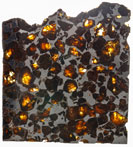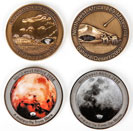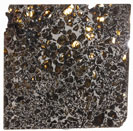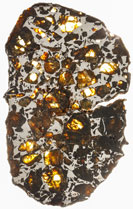| Lot |
Photo |
Description |
Realized |
Lot 984 |
 |
Canyon Diablo Iron-Nickel Meteorite with a Hole. This large four-pound 4 x 3 x 2¼" Canyon Diablo iron-nickel meteorite is a palm sized specimen of one of the most sought after iron meteorites by collectors. Most currently available Canyon Diablo meteorites are just a few grams in weight. Any sizeable specimens are hard to come by as the area around Meteor Crater near Winslow, Arizona has been closed for years. The nearly one mile in diameter crater was created over 50,000 years ago when a 50 foot in diameter meteor exploded high over the Arizona desert. This popular esthetic meteorite possesses several deep distinctive regmaglypts (thumbprints) plus many smaller ones. The most unusual regmaglypt is a one inch deep and one inch wide hole which was probably caused by a graphite nodule falling out during the fiery entry into the earth's atmosphere. Since no specimens are available from the source at Meteor Crater, the only way to acquire a specimen is when specimens are made available from collections. $1,600 - 2,200
View details and enlarged photo
| Realized
$1,000 |
Lot 985 |
 |
Moon Rock From Lunar Meteorite. This fairly large .9164 gram 32 x 22 mm thin slice of the moon meteorite Dhofar 1180 is housed in a special membrane box for visibility on all sides. Lunar meteorites are the most desirable and expensive of all the types of meteorites recovered and are even rarer than meteorites from Mars. It has been classified as a Lunar feldspathic basalt-bearing regolith breccia which means that it is a mixture of several different types of moon rocks with 75% Lunar highlands material and 25% Lunar Mare material. These basaltic Lunar rocks were melted and partially mixed together when a large meteorite crashed into the moon millions of years ago. This rock mixture was vaporized and ejected from the moon and eventually made its way to the earth. This section is large enough to observe the white, brown and black clasts in a dark gray matrix. This very valuable meteorite is housed in a clear membrane box and a 8 x 6½" Riker box. $1,200 - 1,500
View details and enlarged photo
| Unsold |
Lot 986 |
 |
Meteorite Brahin Pallasite. Pallasites are indeed "Gemstones" from space as they are a rare type of iron-nickel meteorite that has beautiful crystals interspersed in the iron-nickel matrix and when cut and polished yield unbelievable translucent crystals of yellow/green olivine. The first Brahin Pallasite meteorite was discovered in 1810 by farmers in the Minsk, Belorussia region of Russia. In the 200 years since then only eleven meteorites have been found from this fall totaling about 1000kgs. This large 61.7 gram 3 x 2¾" polished specimen displays many translucent golden yellow crystals evenly interspersed throughout the iron-nickel matrix and even has original fusion crust on the top. Housed in a 5½ x 4½ " Riker Mount. $650 - 900
View details and enlarged photo
| Unsold |
Lot 987 |
 |
Meteorite Campo del Cielo 5½ Lbs. This 5¼ x 3½ x 2½" Campo del Cielo iron-nickel meteorite is exceptional as it contains regmaglypts. Regmaglypts (thumbprints) formed when the meteor passed through Earth's atmosphere, explosed and the troilite (iron sulfide) in the meteorite melted before the meteorite struck the earth. First recorded by the Spanish in 1576, the huge fall of Campo del Cielo (Valley of the Sky) iron-nickel meteorites occurred thousands of years before in Argentina. It is interesting to note that Iron-Nickel meteorites were the strongest metal objects know to mankind before the discovery of steel. Swords forged from meteorite iron were much stronger and less brittle than swords made from cast iron because of the high nickel content of the meteorites. This desk sized iron-nickel meteorite would make an "out of this world" paperweight. $600 - 700
View details and enlarged photo
| Realized
$375 |
Lot 988 |
 |
Martian Mini-Meteorite Complete And Uncut. Meteorites from the planet Mars are so rare that only small fragments are available for sales having been identified as being from Mars because of their chemical analysis and age. It is believed that Martian meteorite NWA 4783 was blasted off the surface of Mars by a meteorite impact around 2.1 million years age. This Martian meteorite (named North West Africa 4783) was found in Algeria in 2005 and is classified as a Martian basaltic shergotite. This complete greenish uncut meteorite is 20 x 13mm weighing 3½ grams has 100 percent of its original black fusion crust on the 20mm of the top side. This is a rare opportunity to acquire a complete meteorite. Presented in a 8 x 6¼" Riker mount. $1,300 - 1,600
View details and enlarged photo
| Unsold |
Lot 989 |
 |
Meteorite From Biggest Strike Since 1907. On February 15, 2013 a large 8-10 ton 50 foot long meteor exploded 10-15 miles above the ancient city of Chelyabinsk, More than 95% of the recovered meteorites are extremely small, less than 3 grams in weight. This beautiful fresh 40 x 18 x 10 mm complete stony meteorite designated as a LL5 SR4 weighs 14.1 grams LL5 SR4 means that it has a low iron content of about 10% which is low even for a stony meteorite. This meteorite fragment is very interesting in that it has two different fusion crusts. The top has a thick dark brown fusion crust that formed high in the earth's atmosphere when the meteorite first broke up and the bottom side has a much thinner black fusion crust that started to form after the final tremendous explosion and did not have enough time to become thick. The small sections that are not covered by fusion crust offera window inside of the meteorite displaying its light gray matrix mixed with specks of iron and beige dn brown chondrules It is not possible to obtain a fresher meteorite and it is very valuable for study in that there has been no contamination with Earth rocks and erosion. Comes housed in a 8X6 inch Riker mount with a photo of the explosion. $525 - 700
View details and enlarged photo
| Unsold |
Lot 990 |
 |
Meteorite Gem Quality Stony. There are basic three types of meteorites, stony, stony-iron (Pallasites) and Iron-Nickel. All three types of these meteorites come from the asteroid belt (except for the Mars, Moon and Vesta meteorites) and formed when our solar system formed some 4.57 billion years ago making them far older than any rocks found on earth. This gem quality 3X2.5X1.75 inch 372.7 gram (nearly one pound) was found in the Sahara desert and is designated as a non characterized NWA meteorite. It is magnetic like all stony meteorites that do not come from a planet and is probably an ordinary chondrite meteorite with chondrules. Chondrules are mostly round bits of material that cooled and joined together to form the asteroids and planets when the solar system was formed. What makes this stony meteorite special is its esthetic shape and being completely covered in its original fusion crust with a bit of desert sand in its crevices. It looks as fresh as if it fell yesterday. It comes with a stand for display and would make an excellent example of a stony meteorite in any meteorite collection. $500 - 600
View details and enlarged photo
| Realized
$313 |
Lot 991 |
 |
Meteorite Jewelry Necklace. Made from the stony meteorite NWA 869, this 22 inch long necklace is made with irregular sections of the stony meteorite found in the Sahara desert with six .25 inch diameter sterling silver Bali style beads, a 2.75 inch sterling silver extension chain and a sterling silver lobster-claw clasp. At 3.57 billion years old, these meteorite beads are older than any rocks or gemstones on Earth and have small pieces of chondrites in the medium brown matrix that authenticate them as being from a meteorite as no rocks on Earth today have chondrites in them. The beads are magnetic because even stony meteorites have up to 20% iron flakes in them. These genuine meteorite pieces from the Sahara desert make this necklace a rare and unique gift. Comes with a certificate of authenticity. $400 - 550
View details and enlarged photo
| Realized
$425 |
Lot 992 |
 |
Meteorite Jewelry Round Beads with 14K Gold Beads. Handmade designer necklace is 21 inches long and is made up of 45, 8mm NWA 869 meteorite round beads and eight 14K gold large spiral spacer beads and spiral bead clasp. Each of the 8mm round meteorite beads has been individually formed and polished from larger meteorite specimens and each one has its own individual designs that show flecks of metal (iron) as well as chondrites. Chondrites are the very first material that formed out of the hot solar gases that formed the solar system and are currently being studied by scientists to learn about the composition of the original building blocks of the solar system. $600 - 800
View details and enlarged photo
| Realized
$480 |
Lot 993 |
 |
Collection of Four Scarce Meteorite Medals. Each of these limited edition meteorite medals contains a fragment of the meteorite being commemorated. This is a type set of meteorites containing a Martian, Lunar, stony and iron-nickel meteorite. Each medal is 48 mm in diameter in either brass or copper nickel. The Martian meteorite NWA 2986 number 110 of 250 was discovered by Nomads in the Sahara Desert in2006. The Lunar meteorite a feldspecific breccia NWA 2995 was found by Nomads in the Sahara Desert in 2005 and this medal is numbered 207 out of 250. The stony meteorite NWA 869 medal #738 of 1000 was found by the Nomads in the Sahara Desert in 2000. The iron-nickel meteorite Camp del Cielo #437 out of 1000 was described by the Spanish explorers in Gran Chaco, Argentina in 1576. $500 - 700
View details and enlarged photo
| Unsold |
Lot 994 |
 |
Meteorite Necklace with Vial of Olivine Crystals. This 17 inch black leather necklace with a 2 inch extension features a vial of olivine/Peridot crystals taken from the famous Admire pallasite meteorite discovered in 1881 in Admire, Kansas. Pallasites are a rare type of iron-nickel meteorites that contain crystals of olivine which is known as Peridot in its gem form in an iron-nickel matrix. The glass vial which can be hung from any chain, contains about 20 crystals of olivine and some near gem quality peridot that were removed from an Admire meteorite and are literally gemstones from space. $300 - 450
View details and enlarged photo
| Unsold |
Lot 995 |
 |
Meteorite Rare Ataxite. Ataxites are a rare type of iron-nickel meteorite that do not exhibit a Widmanstatten pattern when they are etched due to their high nickel content. Ataxites are known as ungrouped irons as they do not match the chemistry of any of the other iron-nickel groups and most certainly come from a different planetary body than the other irons. Dronino is an ataxite that was found by a Russian mushroom hunter in July of 2002 near the Russian village of Dronino. Over 600 meteorites were found totally about 3000 Kg with the largest meteorite being 250Kg. All of the meteorites were heavily weathered and rusted from being buried underground from 1-6 feet. The weathered and rusted crust has been removed from this specimen leaving a solid iron-nickel core. It is not known when this meteorite fell to earth but it was certainly more than one thousand years ago since the area was inhabited then and no mention of such a spectacular cosmic event is recorded. This end piece is 6¼ x 2 ¾ x 2" and weighs 1383 grams (over three pounds). The cut side has been polished and etched exhibiting sulfide and chromite inclusions. The natural uncut end has a bright gun metal color with the usual ragged surface and some small regmaglpts that are typical of an esthetic Dronino ataxite meteorite. $1,500 - 2,250
View details and enlarged photo
| Unsold |
Lot 996 |
 |
Meteorite Seymchan Pallasite. Two meteorites weighing 323 Kg were found in 1967 in Seymchan, a Magadan district in far eastern Russia. Originally, Seymchan was believed to be just an iron-nickel meteorite but recently olivine crystals were found in parts of some of the Seymchan meteorites which makes it a far rarer Pallasite. Pallasites are literally gemstones from outer space containing olivine crystals mixed in with the iron-nickel matrix. This large 4½ x 4" 170.2 gram slice has more than 50% olivine crystals and silicate inclusions in its iron-nickel matrix and has been polished to reveal this interesting interior including many translucent olivine crystals. The silicate inclusions are found in a type of stony iron meteorite known as a Mesosiderite. Therefore, this Seymchan section is a mix between a Pallasite and a Mesosiderite. The olivine cryatals in Seymchan are smaller in diameter than in most Pallasites. Seymchan slices are remarkably stable. Comes in a 8 x 6" Riker Mount for presentation. $2,500 - 3,000
View details and enlarged photo
| Unsold |
Lot 997 |
 |
Meteorite Sikhote-Alin with Flow Lines. 2½ x 2½ x 2" 320 gram Sikhote-Alin Iron-Nickel meteorite is a rare example of an interesting shrapnel type Sikhote-Alin meteorite with many crevices, surface scrapes and fresh fusion crust covered with delicate flow lines and globs of metal similar to a melted candle features of the huge explosion that took place in 1947 high above the Sikhote-Alin mountains of Siberia. The delicate flow lines that naturally occurred when the meteorite passed through the earth's atmosphere are only found on pristine iron-nickel meteorites such as this museum quality Sikhote-Alin. Includes stand. $750 - 1,150
View details and enlarged photo
| Unsold |
Lot 998 |
 |
Meteorite, 21 Lb. Campo Del Cielo. Impressive 9½ x 7 x 2" 20.9 lb. Campo del Cielo iron-nickel meteorite fell to the earth over 4,000 years ago in mountainous region of Gran Chaco, Argentina, This quintessential large meteorite has several medium to large regmaglypts and looks much larger than it actually is because of its large surface area. It was recovered from the mountainous new Campo sight that yields meteorites with the best shape and surface quality. Most of the large meteorites have been recovered from this field and are becoming quite difficult to locate. This large esthetic Campo del Cielo looks like what most people think of when they visualize a meteorite and comes with a metal stand for display. $2,000 - 2,500
View details and enlarged photo
| Unsold |
Lot 999 |
 |
Meteorite, Gem Quality Stony. There are basic three types of meteorites, stony, stony-iron (Pallasites) and Iron-Nickel. All three types of these meteorites come from the asteroid belt (except for the Mars, Moon and Vesta meteorites) and formed when our solar system formed some 4.57 billion years ago making them far older than any rocks found on earth. Most stony meteorites are sectioned for collectors and acquiring a fresh gem quality stony meteorite is rare. This gem quality 4 x 2½ x 2" 810 gram (nearly two pounds) was found in the Sahara desert and is designated as a non characterized NWA meteorite. It is magnetic like all stony meteorites that do not come from a planet and is probably an ordinary chondrite meteorite with chondrules. What makes this stony meteorite special is its esthetic shape with regmaglypt types impressions and being more than 90% covered in its original fusion crust with a bit of desert sand in the areas not covered. It looks as fresh as if it fell yesterday being in the top 5% of all meteorites found in the Sahara desert. $800 - 1,100
View details and enlarged photo
| Unsold |
Lot 1000 |
 |
Three Types of Vesta Meteorites. Vesta is a very large asteroid with a diameter of over 326 miles and has a gigantic impact crater at its South Pole that is so deep that it exposes the asteroid's interior. Vesta has been identified, using a spectograph,as the source for the three types of meteorites: NWA 2126 is a brecciated cumulate Eucrite that formed from the impact of a large asteroid that hit Vesta. This 26 x 25 mm slice weighs 4.9 grams and shows a mixture of the surface rocks from Vesta with white,gray light and dark brown inclusions. The second meteorite type is called Howardite and comes from a deeper part of the impact crater. NWA 3117 is a 18 x 18 mm fragment weighing 3.4 grams with a light gray matrix color with some white and dark gray inclusions. The third type of meteorite is called a Diogenite which comes from deeper inside the huge impact crater. This slice of NWA 5480 is 25 x 21 mm weighing 4.5 grams showing several different colored inclusions in a light gray matrix. These three important meteorite specimens tell a story about an event that happened billions of years ago at the south pole. In a 8x 6" Riker mount. $525 - 650
View details and enlarged photo
| Unsold |
Lot 1001 |
 |
Meterorite Admire Pallasite. This large complete section is 4¼ x 2½" weighing 72 grams and is loaded with clear translucent yellow-green olivine crystals some approaching gem quality. The Admire Pallasite named for its discovery in 1881 in Admire, Lyon County, Kansas is one of the most beautiful of all known pallasites and is unique in pallasites in the olivine crystals having a characteristic called chatoyancy. Chatoyancy is defined as the change of luster within a gemstone due to the way the crystals reflect light. This rare occurrence is caused by tiny void tubes which appear like the effect of fiber optics when the gemstone is cut parallel to the tubes. This effect can be observed in some of olivine crystals of the Admire Pallasite when viewed in low light as the crystals seem to turn on and off by themselves. Comes with a plastic stand. $1,100 - 1,500
View details and enlarged photo
| Unsold |